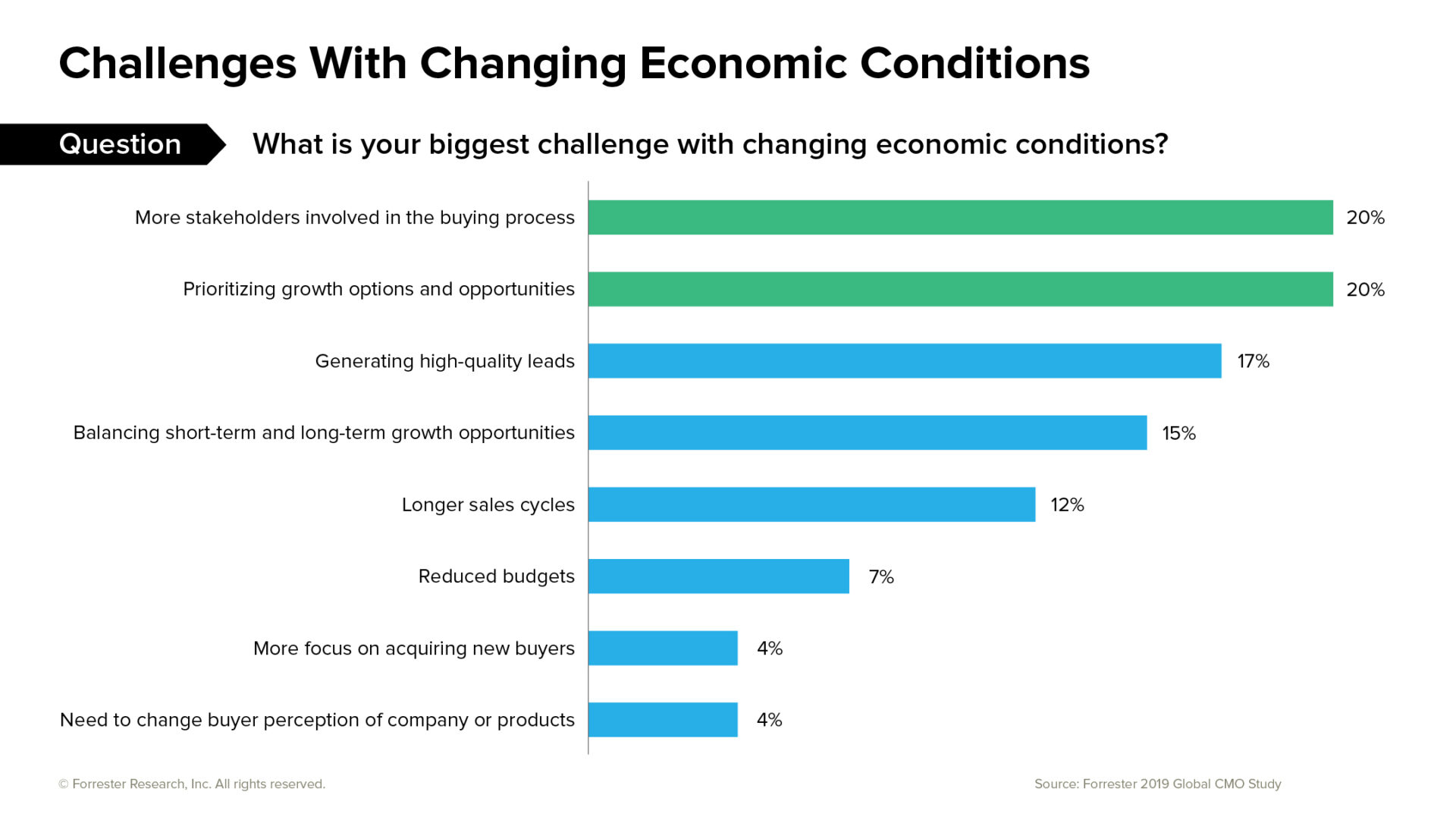Survival Tips for the B2B CMO In Changing Economic Conditions
The Forrester 2019 Global CMO Study, representing responses from over 350 B2B marketing leaders, revealed that adapting to changing economic conditions was the top influence on their marketing strategy over the next two years — long before COVID-19 descended upon us. Now, it’s on everyone’s mind.
Economic adaptation refers to changes in behavior on the part of individuals, businesses, and even entire societies in response to changes in the economic environment. We’re certainly facing a whole new level of economic adaptation due to the impact of COVID-19 — in fact, it’s only exacerbating the ongoing economic challenges that B2B marketing leaders were already concerned about.
But what specific problems do these changing economic conditions pose for marketing leaders? The chart below reveals what the study showed when we asked marketing leaders to tell us what their biggest challenges with adapting to changing economic conditions.

As helpful as it is to know what the biggest challenges are, what do you do about it? Well, if your organization is beginning to experience one or more of these issues, the following actions address each of the most common challenges (ranked from highest to lowest) in a changing economic climate:
- More stakeholders involved in the buying process. A failure to identify key personas and their roles in the buying group creates gaps that can stall the progression of a sales lead or opportunity. Understanding the composition of the buying group and the associated buying need is central to addressing this challenge. The first step in identifying the buying group is constructing an audience framework that summarizes the target market segments and sub-levels such as region, industry, organization type, buying centers, and the key personas involved in the purchasing process. Next, map persona engagement levels by documenting each persona’s participation in the buying decision process. Understanding buying groups and personas will help prioritize how to deal with more stakeholders in the buying process.
- Prioritize growth options and opportunities. One trend we continue to see with our annual B2B CMO Study is that the vast majority of organizations are pursuing multiple growth strategies. Defining, prioritizing, and aligning on the paths an organization plans to pursue for growth turns ordinary growth into intelligent growth. Identifying and prioritizing the growth pillars that the organization will pursue is the foundation for a measured, intelligent approach to achieving desired growth objectives. It also helps marketing leaders address the ongoing challenge of maintaining focus in the face of increasing business demands and limited marketing resources. Five core types of growth strategy (markets, buyers, offerings, productivity, acquisition) provide the construct that marketing leaders need to ensure that marketing strategy aligns to the corporate growth objectives, as well as the strategies of sales and product counterparts, and that it incorporates and emphasizes the most critical elements for success. This exercise is something every organization has the power to do, and it has the potential to significantly boost results.
- Generating high-quality leads. Agreement between sales and marketing on what constitutes a “quality” lead is essential to tackling this issue. Even if you already have an agreement, economic adaptation is a good time to revisit the agreement. Evaluate lead quality levels, create a shared understanding of the type of demand being created, and consider the sales structure, deal complexity and average selling price to determine if the economic situation warrants a change to what constitutes a high-quality lead. Agreement is essential for sales and marketing alignment and will help to ensure lead generation efforts are focused and aligned across the revenue engine.
- Balance long-term and short-term growth opportunities. Most organizations identify the growth strategy as part of strategic planning — it’s a long-term view. Those strategies also need to be aligned to an annual plan. Marketing leaders should work with their portfolio marketing teams to assess the changing market dynamics and the competitive landscape. Evaluate target buyers and target markets to plot the opportunities according to market conditions and internal capabilities to prioritize efforts and find the balance between viable short-term opportunities and longer-term growth strategies. Assess how the economic conditions impact the balance of efforts on retention vs. new logo acquisition.
- Longer sales cycles. In times of uncertainty, longer sales cycles are inevitable. In a recent blog post by my colleague Steve Silver, “Seven Tips for Selling in the Age of a Pandemic,” Steve provides tips for sales that include the importance of communicating the organization’s value in a concise manner. The importance of understanding buyer needs at the various stages of their buying journey becomes further amplified in deteriorating economic conditions. Arm sales with the content they need to ensure they can deliver value in every interaction. Marketing can provide insights on the types of interactions that most influence buyer decision-making that can enable greater sales effectiveness.
- Reduced budgets. In an economic downturn, most marketing leaders will feel the pressure of reduced budgets. Now is the time to align program budget allocation with your campaign strategy. Establish (or revisit) campaign objectives, scope, and funding, allocate program dollars to campaigns that target specific market segments with specific tactics and timelines. As campaigns are executed, establish strong budget controls, measure campaign spending and performance, and release or reallocate any unspent funds. The shift from live events to virtual interactions is a good time to reassess how well the marketing mix aligns to buyers’ changing needs.
- More focus on acquiring new buyers. The Forrester 2018 B2B Leadership Study examined the big levers organizations were pulling to support their growth strategies. The study revealed that as B2B organizations pursue new buyers, the most frequently deployed strategic initiative is the implementation of new processes. For marketing, it means implementing processes that ensure an audience-centric approach. This can include redefining how demand is measured and moving from tracking leads to demand units. A demand unit is composed of individuals within a single organization with various roles and a common business need driving them to make a purchase decision together. The role of new buyers in the decision-making process must be examined as part of this growth strategy.
- Change buyer perception of the company or products. Addressing this challenge begins with identifying where to focus efforts. Measuring how audiences comprehend a brand, along with their resulting views and associations, can be difficult for B2B marketers to execute. Brand perception often is complex; for example, a brand may have very strong awareness and positive perception with one audience and relatively low awareness or misaligned perception with another. Understanding areas of traction and areas of weakness can guide how future brand activation programs are constructed.
Changing economic conditions happen. Recognizing the need to identify the specific problems for your organization to address will help economic adaption efforts tremendously.
